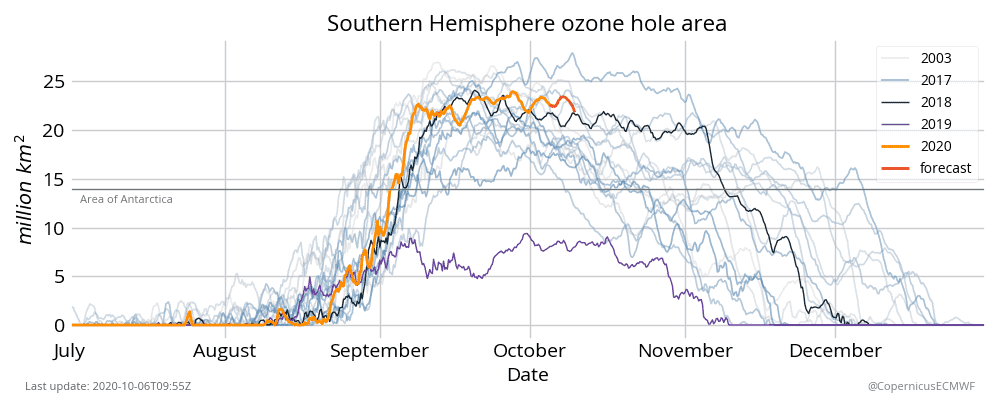The ozone hole shifts in size with every year and season, but this year, it’s been the largest and deepest seen in recent times, according to scientists at the Copernicus Atmosphere Monitoring Service (CAMS).

The maximum annual size of the ozone hole above Antarctica was much bigger this year compared to recent years, hot on the heels of an “unusually small and short-lived” one in 2019, CAMS explained. This event highlights that there’s still work to be done on restoring the ozone layer and that we need to better enforce current bans on chemicals such as chlorofluorocarbons (CFCs), which are known to contribute to ozone depletion.
No ozone zone
“There is much variability in how far ozone hole events develop each year. The 2020 ozone hole resembles the one from 2018, which also was a quite large hole, and is definitely in the upper part of the pack of the last fifteen years or so”, said Vincent-Henri Peuch, director of CAMS.
The ozone layer in Earth’s upper atmosphere absorbs most of the incoming ultraviolet radiation (UV) from the sun that would otherwise be damaging to life on our planet.
Human-made chemicals, in particular refrigerant gases in the CFC family, however, have severely damaged this layer in the past. Countries all around the globe had to work together to ban such chemicals and help shield humans and wildlife from the very real danger of ozone depletion.
Despite the Montreal Protocol, which banned the production and use of CFCs, being signed in 1978, the ozone layer has not yet recovered fully. The ozone hole has become an unfortunate mainstay in the Earth’s upper atmosphere, showing yearly and seasonal variations in size. During the Arctic winter (these gases tend to concentrate at the poles), incoming force chlorine and bromine compounds into more reactive ones, which interact with ozone, depleting the layer.
CAMS explained that this year’s large rip in the layer was generated by a “strong, stable and cold polar vortex”. The polar vortex is an area of long-term low air pressures where temperatures can reach almost -80°C (-112°F); this vortex tends to remain centered around the Ross ice shelf area.
“With the sunlight returning to the South Pole in the last weeks, we saw continued ozone depletion over the area,” Peuch explains.
“After the unusually small and short-lived ozone hole in 2019, which was driven by special meteorological conditions, we are registering a rather large one again this year, which confirms that we need to continue enforcing the Montreal Protocol banning emissions of ozone-depleting chemicals.”
Ozone is considered a pollutant at ground level, and it has a pretty unpleasant smell, similar to that of chlorine-based cleaning compounds. It’s a very powerful oxidant (being an unstable molecule with 3 oxygen atoms) and will thus chemically attack living tissues in animals or plants. However, we wouldn’t be alive without it — the ozone layer blocks between 97 and 99 percent of all incoming UV light.


